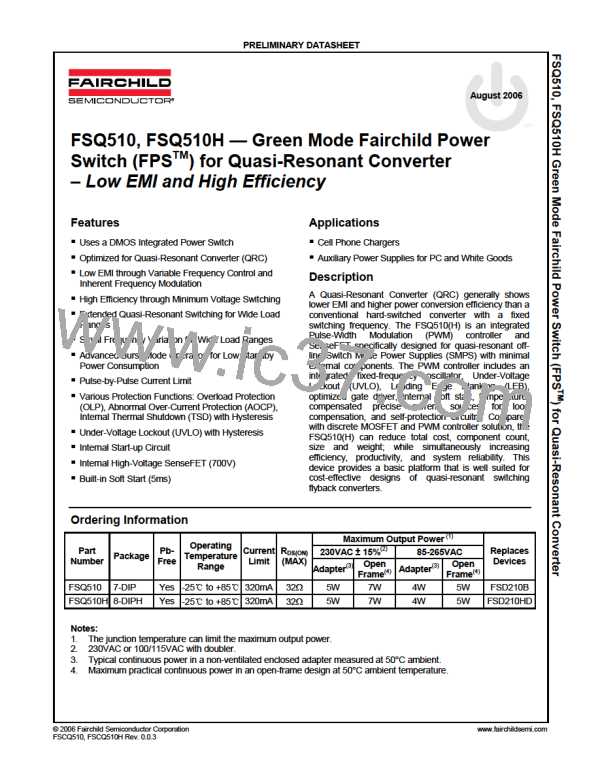PRELIMINARY DATASHEET
7. Advanced Quasi-Resonant Operation: To minimize
Tsmax=10.7us
switching loss and Electromagnetic Interference (EMI),
the MOSFET turns on when the drain voltage reaches
its minimum value in QRC converters. Due to
Discontinuous Conduction Mode (DCM) operation, the
feedback voltage is not changed, despite the DC link
voltage ripples, if the load condition is not changed.
Since the slope of the drain current is changed
depending on the DC link voltage, the turn-on duration
of MOSFET is variable with the DC link voltage ripples.
The switching period is changed continuously with the
DC link voltage ripples. Not only the switching at the
instant of the minimum drain voltage, but also the
continuous change of the switching period, reduces EMI.
So QRC converters can scatter the EMI spectrum
inherently.
Ids
Ids
A
B
tB=7.7us
Ts
Ids
Ids
tB=7.7us
Ts
Typical products for QRC turn on the MOSFET when
the first valley is detected. In this case, the range of the
switching frequency is very wide as a result of the load
variations. At a very light load, for example, the
switching frequency can be as high as several hundred
kHz. Some products for QRC, such as Fairchild’s
FSCQ-series, define the turn-on instant of SenseFET
change at the first valley into at the second valley when
the load condition decreases under its predetermined
level. The range of switching frequency narrows
somewhat. For details, consult an FSCQ-series
datasheet at:
Ids
Ids
C
tB=7.7us
Ts
Ids
Ids
http://www.fairchildsemi.com/pf/FS/FSCQ1265RT.html
D
tB=7.7us
tW=3us
The range of the switching frequency can be limited
tightly in FSQ-series. Because a kind of blanking time
(tB) is adopted, as shown in Figure 11, the switching
frequency has minimum and maximum values.
Tsmax=10.7us
Figure 11. Advanced QRC Operation
Once the SenseFET is enabled, the next start is
prohibited during the blanking time (tB). After the
blanking time, the controller finds the first valley within
the duration of the quasi-resonant detection window time
(tW) (Case A, B, and C). If no valley is found in tW, the
internal SenseFET is forced to turn on at the end of tW
(Case D). Therefore, FSQ510 and FSQ510H have
minimum switching frequency of 93.5kHz and maximum
switching frequency of 130kHz, as shown in Figure 12.
When the resonant period is 2us
130kHz
C
Constant
frequency
A
B
103kHz
93.5kHz
D
Burst
mode
Po
Figure 12. Switching Frequency Range of the
Advanced QRC
© 2006 Fairchild Semiconductor Corporation
FSQ510, FSQ510H Rev. 0.0.3
www.fairchildsemi.com
10

 FAIRCHILD [ FAIRCHILD SEMICONDUCTOR ]
FAIRCHILD [ FAIRCHILD SEMICONDUCTOR ]